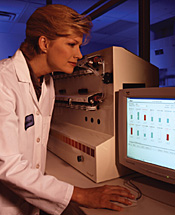The Virtual Aroma Synthesizer™ (VAS) allows the creation of flavors in real time, according to exact customer specifications. This award-winning instrument from Givaudan was cited as a “Technological Breakthrough of the Year,” at the 29th Annual Fragrance Foundation Awards.

Technology Blends Precisely
With the VAS, the aroma of ingredient blends can be evaluated in real time by combining precision instrumentation with human sensory evaluation. The VAS produces vapors from up to 20 ingredients at a time, each substance contained within a saturated headspace. Any material that produces an aroma can be used, such as single chemicals, flavor components, finished flavors, and finished foods and beverages.The VAS precisely measures the flow rate of each ingredient mixed, allowing it to calculate the molar fraction in the vapor phase. The ingredients are mixed together and the aroma is delivered to the user through a nosepiece. After the aroma is created, the computer-driven VAS can translate and quantify a formulation that is stored in memory.
“We can vary the amount of each ingredient in the mixture by a simple mouse click, which results in changing the overall odor—or we can switch off an unwanted ingredient,” explains Bob Antenucci, Ph.D., Givaudan's vice president of flavor science.
Flavor creation can be a tedious process that involves repetitive tasks of blending many different chemicals. After tasting test samples in food and beverage prototypes, revisions are incorporated into further iterations. From two to twenty or more iterations may be necessary to satisfy a customer's desires for a specific flavor profile, to duplicate a target, or to modify and rebalance a flavor.
“The VAS allows flavor chemists to create, evaluate and make desired changes instantaneously, allowing them more time for the creative process,” says Antenucci.
Communication between supplier and customer is greatly enhanced with this creative tool. Verbalizing the perceptions of aromas is very difficult because of the lack of a common descriptive language. Common terms such as green, woody, spicy, and earthy may mean two different things to two different people. Trained sensory panels may spend days or weeks evaluating standards for aroma perceptions before coming to an agreement on what defines “green” or “burnt” for a particular application.
“When five people taste a flavor, we will often get five different descriptions because there is no common language among the tasters,” says Antenucci. “For rapid concept generation with the VAS, the customer, flavorist, and food technologist can collectively build the flavor and experience modifications in real time—there is no need for perfecting descriptive language.”
The VAS saves time—what used to take several days of creative development now takes a few hours. This new tool serves as a bridge between supplier and customer.
For more information: Bob Antenucci at 513-948-8000 bob.antenucci@givaudan.com • www.givaudan.com Givaudan • Write in 236